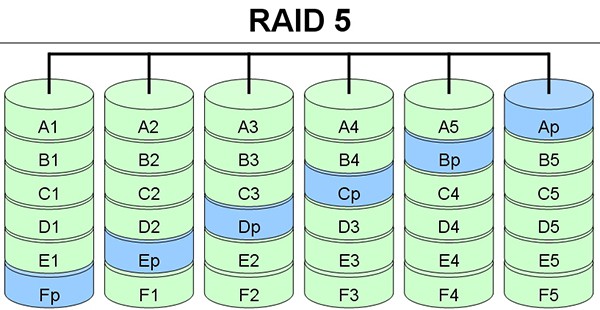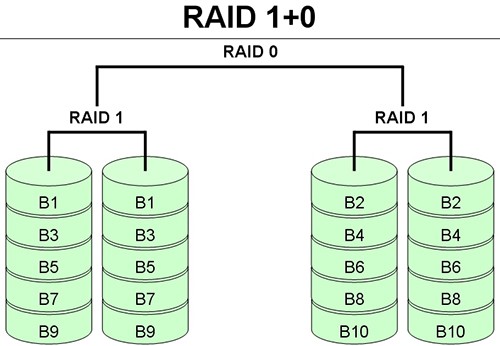RAID stands for Redundant Array of Inexpensive Disks.
- RAID 0 is striping,
- RAID 1 is mirroring ,
- RAID 5 is striping with parity,
- RAID 10 is mirrored sets in a striped set.
[bs_icon name=”glyphicon glyphicon-arrow-right”] RAID 0 is not fault-tolerant. If RAID 1 uses two disk controllers, it is disk duplexing.
Short for Redundant Array of Inexpensive Disks, RAID is an assortment of hard drives connected and setup in ways to help protect or speed up the performance of a computer’s disk storage. RAID is commonly used on servers and high performance computers.
Spanning and Software Striping
Splitting information and writing it across multiple physical disk drives. RAID 0 utilizes this technique.
Mirroring
Duplication of data from one disk drive to another.
Duplexing
Duplicates the disk drive as well as the disk controller.
Deferred
Data is cached in cache memory and writes to the hard drive as the disk drive becomes available.
Hot Swapping
Failed disk drives can be replaced and data can be placed back onto the disk drive while the remainder of the system is in operation.
Hot Sparing
Disk drive is automatically initialized into the array when another fails.
Spindle Synchronization
Synchronization of the rotation of all disk drives in the array allowing information to be written all at once.
Versions of RAID
RAID 0
Software stripping and Block Interleave (minimum 2 drives). Data is written to each drive in succession, each block going to the next available drive (striping) for a faster operation and less chance of overloaded. The volume can of course be much larger than any single drive. Since no redundancy is provided, the failure of a single drive will bring the system down. RAID 0 is the fastest and most efficient array type, but offers no fault-tolerance.
RAID 1
Disk Mirroring and Duplexing ( minimum 2 drives ). Drives are used in pairs and all data is written identically to both drives. Each drive can be duplexed by being connected to its own interface controller. The failure of one drive will not bring down the system, instead the other drive will continue to operate. Of course, two drives are now used for the equivalent storage capacity of one drive. There is no performance gain with this level. The array of choice for performance-critical, fault-tolerant environments. Also, RAID 1 is the only choice for fault-tolerance if no more than two drives are desired.
RAID 2
Data striping and bit interleave. Data is written across each drive in succession, one bit at a time. Checksum data is recorded in a separate drive. RAID 2 is very slow for disk writes and seldom used today since ECC is embedded in almost all modern disk drives.
RAID 3
Data striping with bit interleave and parity checking. RAID 3 is similar to lever 2, but more reliable. Data striping is done across the drives, one byte at a time. Usually 4 or 5 drives are used providing very high data transfer rates. One drive is dedicated to storing parity information. The failure of a single drive can be compensated by using the parity drive to reconstruct the failed drive contents. Since the parity drive is accessed on every write operation, the writing of data tends to be slower. The failure of two drives or more can be a problem. RAID 3 can be used in data intensive environments with long sequential records to speed up data transfer. However, it does not allow multiple I/O operations to be overlapped and requires synchronized-spindle drives to avoid performance degradation with short records.
RAID 4
Block interleave data striping with parity checking. As in level 3, RAID 4 uses a single parity drive and block data striping like in RAID 0. The drives in this RAID level function individually, with an individual drive reading a block of data. A failure of the controller will of course be catastrophic. Offers no advantages over RAID-5 and does not support multiple simultaneous write operations.
RAID 5
Block interleave, data striping with distributed check-data on all drives. The one to use for NetWare. Parity information is distributed across all drives. RAID 5 efficiency goes up as the number of disks increases. You can use hot spares to rebuild a failed drive on “the fly”. The best choice in multi-user environments, which are not write performance sensitive. However, at least three, and more typically five drives, are required for RAID-5 arrays.
RAID 6
Extension to RAID 5, which adds a log structured file system providing a mapping between a disk drives physical sectors and their logical representation. As information is written it is placed to sequential physical disk sectors.
RAID 10
Stripped array whose segments are RAID 1 arrays and containing the same fault tolerance as RAID 1. High I/O rates are achieved by stripping RAID 1 segments. Excellent solution for those considering RAID 1 since it provides an good write performance, but is an expensive solution.
RAID 53
Implemented as striped RAID 0 array whose segments are RAID 3 arrays. RAID 53 also contains the same Fault tolerance and overhead as RAID 3. Excellent solution for those considering RAID 3 since it provides additional write performance, but is an expensive solution and requires all drives to have the same synchronization.
[bs_icon name=”glyphicon glyphicon-exclamation-sign”]Note: RAID can be setup with multiple partitions instead of multiple drives for some protection if sectors of the drive become bad. However, if the drive fails you will lose all of your data. For any RAID setup it’s best to use at least two drives to eliminate a single point of failure and total data loss.
What is RAID 0/1?
Some computer and RAID manufacturers have created their own scheme of labeling their RAID devices. For example, RAID 0/1 would mean that it combines the striping of RAID 0 with the mirroring of RAID 1.
Source By:<www.computerhope.com>
To Become Cretified For CompTIA A+ Please Visit This Link ;
Also published on Medium.












